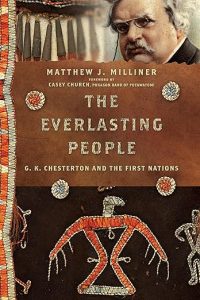 Summary: Using the life and work of GK Chesterton to grapple with North American Indigenous art, history, and Christianity.
Summary: Using the life and work of GK Chesterton to grapple with North American Indigenous art, history, and Christianity.
Every review of The Everlasting People is required to say how unique of a project this is. Unfortunately, I am not equipped to evaluate the project because I am not deeply familiar with either Native American history and art or GK Chesterton. I have some familiarity with both, but not enough to know if Milliner is distorting the record, only enough to be able to follow along with the argument of the book. This is one of the weaknesses of truly original conceptions. That isn’t to say I think this is distorting, only that I do not have the background to evaluate it.
I like books based on lecture series. They are often short, usually based on 3 or 4 lectures, sometimes with a response. But they are often thoughtful about unique topics and designed for a general readership.
If I had to summarize what The Everlasting People, a book that is hard to categorize, is about, I would say it is attempting to give people, generally categorized as white, tools to grapple with their personal and communal cultural history so that there can be a way to move forward in more than just guilt. White guilt, when it is limited to just guilt, does no one any good. The way forward needs to be centered on some process of restoration of relationship (personally and communally). This isn’t “forgive and forget”; this is “remember, process, and work to restore.”
Dr. Matthew Milliner is using his tools as an art historian to tell not just the story of the way that we have forgotten (intentionally) our history in the US around Native American subjugation using art, cultural icons, geography, and local history but also using the theological and cultural thinking of GK Chesterton.
There are two themes that I want to highlight that I think are helpful here. One, while Milliner is clear that the tools of Christianity were used to enslave and subjugate Native Americans, many Native Americans became Christian. They subverted those Christians who were misusing Christianity to persecute. There are multiple examples of this, but as an art historian, Milliner notes how frequently Christian imagery is used in Native American art and how Native American Christians bring native art and practices into their liturgy of Christianity, some of which spread beyond Native American Christian expression. While I am progressive politically and socially, MIlliner is rightly critiquing progressives who want to flatten the story to only tell of the ways Christianity oppresses without allowing the oppressed to tell their own faith stories as stories of empowerment. There is a fine line because this can also be a tokenism story of only telling the empowerment story and resisting the ways Christianity was oppressive. Both parts of that story need to be told.
Second, Milliner is focused on local history and how we must grapple with our history differently from region to region. In the south, it is known that there is a history of slavery and segregation. But other regions can hide their own regional history by pointing to other regions. Milliner has a long section on Chicago and Native American history as a way to tell that midwestern story of oppression toward Native Americans, with examples of monuments to the oppression that function in ways not unlike the civil war monuments that tend to be more present in the south. As a current southerner who was a midwesterner (primarily in Chicago) until my mid-30s, this was a constructive section of the book.
The Everlasting People is an example of a book that tries to grapple with what it means to escape from whiteness (in the sense of a belief in the cultural superiority of a white racial hierarchy). I am not sure I would agree with all aspects, partly because I am not sure I have the background to understand some of the nuances, but the importance is an example of Milliner trying to grapple with his area.
The Everlasting People: G. K. Chesterton and the First Nations by Matthew Milliner Purchase Links: Paperback, Kindle Edition, Audible.com Audiobook